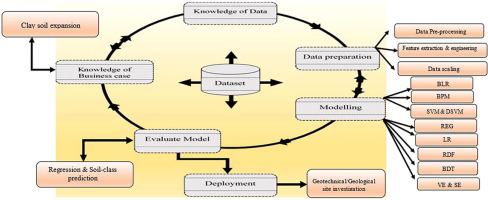Geoscience Frontiers ( IF 8.9 ) Pub Date : 2021-09-13 , DOI: 10.1016/j.gsf.2021.101296 E.U. Eyo 1 , S.J. Abbey 1 , T.T. Lawrence 2 , F.K. Tetteh 3

|
Soil swelling-related disaster is considered as one of the most devastating geo-hazards in modern history. Hence, proper determination of a soil’s ability to expand is very vital for achieving a secure and safe ground for infrastructures. Accordingly, this study has provided a novel and intelligent approach that enables an improved estimation of swelling by using kernelised machines (Bayesian linear regression (BLR) & bayes point machine (BPM) support vector machine (SVM) and deep-support vector machine (D-SVM)); (multiple linear regressor (REG), logistic regressor (LR) and artificial neural network (ANN)), tree-based algorithms such as decision forest (RDF) & boosted trees (BDT). Also, and for the first time, meta-heuristic classifiers incorporating the techniques of voting (VE) and stacking (SE) were utilised. Different independent scenarios of explanatory features’ combination that influence soil behaviour in swelling were investigated. Preliminary results indicated BLR as possessing the highest amount of deviation from the predictor variable (the actual swell-strain). REG and BLR performed slightly better than ANN while the meta-heuristic learners (VE and SE) produced the best overall performance (greatest R2 value of 0.94 and RMSE of 0.06% exhibited by VE). CEC, plasticity index and moisture content were the features considered to have the highest level of importance. Kernelized binary classifiers (SVM, D-SVM and BPM) gave better accuracy (average accuracy and recall rate of 0.93 and 0.60) compared to ANN, LR and RDF. Sensitivity-driven diagnostic test indicated that the meta-heuristic models’ best performance occurred when ML training was conducted using k-fold validation technique. Finally, it is recommended that the concepts developed herein be deployed during the preliminary phases of a geotechnical or geological site characterisation by using the best performing meta-heuristic models via their background coding resource.
中文翻译:

使用机器学习算法和元启发式二分集成分类器改进粘土膨胀的预测
与土壤膨胀相关的灾害被认为是现代历史上最具破坏性的地质灾害之一。因此,正确确定土壤的扩展能力对于为基础设施实现稳固和安全的地面非常重要。因此,本研究提供了一种新颖且智能的方法,通过使用核化机器(贝叶斯线性回归 (BLR) 和贝叶斯点机 (BPM) 支持向量机 (SVM) 和深度支持向量机 (D) -SVM)); (多元线性回归器 (REG)、逻辑回归器 (LR) 和人工神经网络 (ANN))、基于树的算法,例如决策森林 (RDF) 和提升树 (BDT)。此外,首次使用了结合了投票 (VE) 和堆叠 (SE) 技术的元启发式分类器。研究了影响膨胀过程中土壤行为的解释性特征组合的不同独立情景。初步结果表明 BLR 与预测变量(实际膨胀应变)的偏差量最大。REG 和 BLR 的表现略好于 ANN,而元启发式学习器(VE 和 SE)的整体表现最好(最大的 R2 0.94 的值和 VE 显示的 0.06% 的 RMSE)。CEC、塑性指数和水分含量是被认为具有最高重要性的特征。与 ANN、LR 和 RDF 相比,核化二元分类器(SVM、D-SVM 和 BPM)提供了更好的准确度(平均准确度和召回率为 0.93 和 0.60)。敏感性驱动的诊断测试表明,当使用k折验证技术进行 ML 训练时,元启发式模型的性能最佳。最后,建议在岩土工程或地质场地特征描述的初步阶段,通过其背景编码资源使用性能最佳的元启发式模型来部署本文开发的概念。



























 京公网安备 11010802027423号
京公网安备 11010802027423号